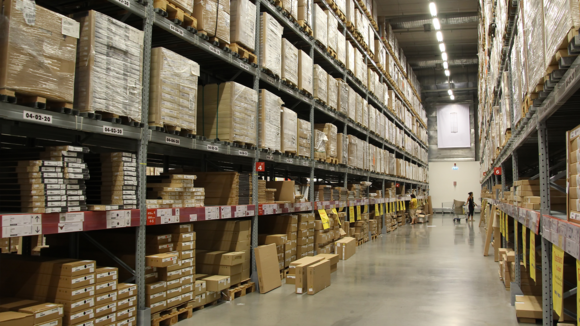

With the SAP Warehouse Management system (WMS), you can benefit from automated and flexible assistance for managing stock and processing goods movements within your warehouse complex. The system offers efficient scheduling and processing of all logistics processes in your warehouse, allowing you to optimize your operations.
The WMS is seamlessly integrated into the SAP environment, which means that when you initiate business processes in other application components, they will trigger physical goods movements in your warehouse. With the WMS, you can easily organize, control, and monitor these goods movements, providing you with greater visibility and control over your warehouse operations.

By mapping out your entire storage facilities in the Warehouse Management system, you can create different types of storage facilities, such as automatic warehouses, high rack storage areas, bulk storage, or fixed storage bins, tailored to your specific requirements. This enables you to effectively manage your inventory and optimize your storage capacity.
With the Warehouse Management system, you have the ability to manage your material stocks at the storage bin level and customize your storage bin configurations to meet your specific needs. By mapping every storage bin in your warehouse in the system, you gain comprehensive visibility of all stock movements, allowing you to easily locate any product within your warehouse.
The Inventory Management and Warehouse Management systems are fully integrated, ensuring that the inventory balance in Inventory Management always matches the warehouse stock in the WMS. This is achieved through the WMS's physical inventory procedure and recording of any stock differences, thereby maintaining accurate and up-to-date inventory records.

The Warehouse Management system facilitates all goods movements related to your warehouse operations, such as goods receipts, goods issues, stock transfers, material staging for production, automatic replenishment, management of hazardous materials, and processing of stock differences.
Using putaway and stock removal strategies tailored to your specific needs, or alternatively using storage units, the Warehouse Management system effectively optimizes warehouse capacities and material flows.

Regular physical inventory is conducted in your warehouse to verify the actual physical stock against the data recorded in the WMS. Any discrepancies are then identified and recorded through the entry of physical inventory differences, which helps to ensure accurate accounting of stock in accordance with the results of the physical stock take.

With the WMS, you have access to a comprehensive overview of all goods issues and warehouse stocks, allowing you to effectively plan, monitor, and optimize your work processes. The system provides valuable insights such as workload projections for upcoming days and alerts for critical warehouse processes, enabling you to take corrective actions in a timely manner of warehouse movements. Additionally, the RF monitor provides you with real-time updates on all warehouse activities, enabling you to exercise control over actual work in the warehouse.

To ensure efficient and cost-effective work processes in the warehouse, you can easily and clearly manage the work steps of warehouse workers through mobile radio-frequency terminals.
By establishing a radio frequency (RF) connection, mobile data entry ensures fast and accurate data transfer. The RF devices receive data directly from the SAP system and transmit data back to the system. Barcodes are used to capture and verify information, allowing you to maintain a high level of accuracy and quality in your warehouse operations.

The WMS is equipped with an interface to external systems, such as warehouse control units, enabling you to seamlessly integrate automatic putaway, stock removal, or forklift control systems into the warehouse management system for all warehouse movements. This is made possible using the ALE (Application Link Enabling) interface.
There are currently 3 versions of WMS’s being offered or supported by SAP with varying capabilities, viz. ECC-WM, Stockroom Management system and Extended WMS.
SAP S/4HANA 1909 offers Stock Room Management as an option for ECC-WM customers who do not require advanced functionality found in SAP EWM and do not extensively use warehouse processes. This option allows customers to upgrade to SAP S/4HANA without undergoing a complete WM transformation and continue using the basic warehouse processes present in their existing ECC-WM applications.
SAP Warehouse Management (WM), part of SAP R/3, was released in 1993, and SAP has continuously improved SAP WM from release to release. The introduction of SAP EWM in 2005 did not directly replace the SAP WM system. Instead, it provided an alternative for warehouses that required additional functionalities available in SAP EWM.
However, the customer must be aware that the end of mainstream maintenance for SAP Business Suite 7 core releases also means that for SAP WM as part of SAP ERP 6.0, maintenance ends in 2025, so the customers are advised to upgrade to S4Hana and choose either EWM or Stockroom management system depending upon their requirements.
Customers who operate large and complex warehouses can choose to implement the Extended Warehouse Management (EWM) module, which offers similar functionality to SAP WM/Stockroom Management but provides greater flexibility in building objects such as warehouse structure, picking, put away, and handling units (HU), RF as well as advanced features including yard management, value-added services, cross-docking, and labor management.
These are the main differences between different Warehouse Management Systems
| Features / Comparison Parameters | Stock Room Management | ECC-WM | Extended WM |
|---|---|---|---|
| Architecture | Part of S/4 ERP |
Part of ECC ERP |
Part of S/4 ERP |
| Barcode Scanning / Mobile Execution | Yes | Yes | Yes |
| Consolidation and Deconsolidation | No | No | Yes |
| Basic Inbound | Yes | Yes | Yes |
| Basic Outbound | Yes | Yes | Yes |
| Physical Inventory | Yes | Yes | Yes |
| Complex Processes (like layout-oriented storage control) | Yes | No | Yes |
| Internal Warehouse Movements | Yes | Yes | Yes |
| Wave Management | No | Yes (but limited) | No |
| Cross-Docking | No | Yes | Yes (advanced) |
| Labor Management | No | No | Yes |
| Task and Resource Management |
No |
Yes |
Yes |
| Value-Added Services (VAS) | No |
Yes |
Yes (advanced) |
| Yard Management | No | Yes | Yes (advanced) |
| Slotting | No | No | Yes |
| Material Flow System | No | No | Yes |
| Serial Numbers | Yes (through HUM) | Yes (through HUM) | Yes |
| SSCC Numbering of HUs | Yes | Yes | Yes |
| MFS Support | No | No | Yes (with restriction) |
| WM-PP Interface | Basic | Basic | Advanced |
| WM-QM Integration | Very Basic | Very Basic | Advanced |
| Physical Inventory | Yes | Yes | Yes |
| WM-SAP TM Integration | No | No | Yes (ASR advanced shipping and receiving) |
| Complexity of Warehouse supported | Low Complexity | Medium | Medium to high Complexity |
➡️ Smooth takeover from the implementation team.
➡️ Data Migration: material master data upload, initial WM Stock Upload, Mass Storage Bins creation.
➡️ System monitoring: Idoc monitoring, batch jobs monitoring, runtime errors monitoring.
➡️ Performing User training activities and support, working closely with Business key users in case of any difficulties they encounter during daily activities.
➡️ Solving rapidly any issues that occur in the system in the WM/EWM (Warehouse Management) area: errors related to incorrect master data setup, errors related to posting of material movements, inconsistencies IM- WM/EWM to stocks.
➡️ Rework for enhancements that do not work as expected.
➡️ Performing Idoc monitoring and corrective actions for failed Idocs.
➡️ Analyzing and providing solutions for any issues reported with WM/EWM related reports – queries, standard reports, custom reports.
➡️ Analyzing and providing solutions for errors reported by Business users in WM/EWM activities: errors related to incorrect material master data setup, errors related to posting of material movements, Inconsistencies IM- WM/EWM to stocks.
➡️ Analyze and solve runtime errors which occur in the system.
➡️ Analyzing failed batch jobs and perform corrective actions.
➡️ Debugging
➡️ Support during Physical inventory period
➡️ Enhancements of standard WM/EWM reports
➡️ Creation of custom WM/EWM reports and queries
➡️ Enhancements of standard SAP WM/EWM functionalities: adding custom fields in Reports, activating user exits for Picking/Put away processes.
➡️ Creating new Bin Structures for mass bin creation.
➡️ Updating/creating new search strategies for picking and put away processes.
➡️ Enhancement of standard packing functionalities.
➡️ Designing and implementing new interfaces between SAP and other internal or external systems: interfaces with Automated warehouse systems like Conveyer Belts, Automatic High Rack System, etc.
➡️ Implementation / Enhancement of RF Functionalities
➡️ Mass updates of master data: Storage bin attributes, material master warehouse data.
➡️ Creation of new WM/EWM organization elements like Storage type, storage section, picking areas etc.
➡️ System conversion from ECC to S4/HANA
➡️ Assisting with support from SAP.
➡️ Enhancement of standard forms/Labels